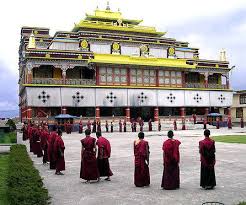Sikkim TRAVEL
In pre-historic times, Sikkim was inhabited by 3 tribes viz., Naong, Chang and the Mon. The Lepchas entered Sikkim later and absorbed them completely. They resorted to the practice of electing a leader whose advice & counsil was sought on crucial matters & followed. The Tibetan migration in early 17th century led the Lepchas to shift their habitats so as to avoid conflict.
Meanwhile they struggle among the followers of the "Yellow Hats" & the "Red Hats" in Tibet forced the latter to seek refuge in Sikkim, where they attained the status of aristocracy & gradually dominated the State. In order to avoid any possible opposition from the Lepchas these immigrants chose one venerable person Phuntsog Namgyal as the temporal & spiritual head of Sikkim. He relocated his capital to Yuksam & estlablished a centralised government.
Tensung Namgyal who succeeded his father in 1670 moved his capital to Rabdentse. During the reign of Tashi Namgyal who was throned in 1914, Sikkim underwent a number of reforms. Forced labour was abolished. Gambling was made illegal. Landlords' courts were abolished. Developmental plans were drawn up for which aid from India was secured. Executive & Judicial powers were decentralised. Tashi Namgyal died on 2nd December 1962, & was succeeded by his son Palden Thondup.
He was married to a Tibetan lady Sangey Deki. She died in june 1957 & Palden Thondup got married to Hope Cooke, who gave birth to a daughter Hope Leezum & a son, but neither their marriage nor Kingdom survived a decade. Growing agitation in 1973 against the monarchy led to the administration's collapsed & Indian troops stepped in which was followed by political arm wrestling for power. In 1975 Sikkim was merged to become India's 22nd State.







